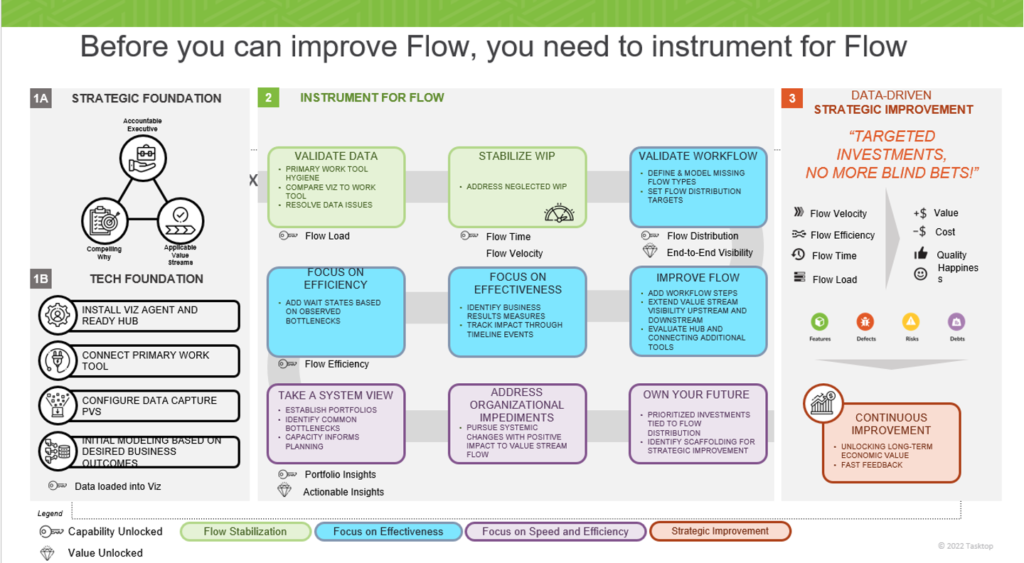
Value stream management (VSM) is about helping teams work smarter and faster, but how do you begin? At our recent Planview Accelerate Customer Conference, the Lead Scrum Master at a Fortune 100 financial services organization shared their best practices for starting VSM in an organization. Below is a summary of the presentation, including practical, tactical tips for using flow.
Tip #1: Start With the Data
Don’t expect instant results with a VSM solution because your data will likely need extensive cleanup. Sync the data immediately so you can start evaluating and sanitizing it. This process will take time, but it is necessary to begin understanding the “true flow of your work.”
For example, an Agile Release Train (ART) could have closed a Feature but left stories and bugs open underneath. Or another team might be keeping old Features open unnecessarily. These types of issues clog the backlog and negatively affect your flow.
Tip #2: Take a Step-By-Step Approach
Eventually, you’ll be looking at a clean backlog, with relevant, prioritized Features that meet the organization’s strategic goals. Getting from here to there requires several steps.
An optimal VSM rollout includes the following:
Create two plans
Create a plan for adoption/change management and one for maturity. These should remain separate to avoid confusion. It’s crucial that teams understand what you are trying to achieve with VSM and work together effectively.
Plan for baby steps
It will take time for everyone to adapt. Meet everyone where they are in this process and always be available for questions.
Consider the audience
You’ll have different conversations with business partners than with the scrum master, product owners, RTEs, and others. Using the language each is accustomed to, you’ll be able to better communicate the usefulness of VSM.
Have a champion at every level
Your team, squad, train, portfolio, and business partners can help you promote the ideas of real process improvement. Get them to communicate the benefits, such as removing team blockers to get to market faster.
Consider change management
A VSM rollout involves more than just technology. For example, to succeed you must organize teams, trains, and portfolios around value streams (a platform or a product) and how you are delivering value to the business.
It’s critical to solicit and incorporate feedback in this process. Open channels of communication encourage continuous learning and adoption, which is critical for advancing your VSM maturity.
Tip #3: Create a Placemat
With Planview Viz, the financial services company used the placemat process depicted below to instrument for flow. This diagram takes you through the set-up process, from validating data to stabilizing WIP to improving overall flow.

Using the placemat, they were able to create their own heat map that tracks how the VSM rollout was progressing, incorporating elements such as:
- Set up: Are the tools synced up? Are you gathering data?
- Adoption: How many are using the solution? Do you have at least one person trained?
- Expertise: Do you have another champion to help you with projects such as Flow Distribution® and organizing around flow types?
- Analyzing data: Do you have neglected WIP? Is there so much in progress that teams cannot get the flow of work to go through?
- Optimizing flow: Flow Time is one of the easiest things to measure. With a program increment of 90 days, are you completing your Features within that time frame? With two-week sprints, are you closing stories and bugs during that period?
Tip #4: Evaluate Progress
Finally, it’s important to know where you are going on this VSM journey and to develop concrete ways of evaluating adoption.
One best practice is to incorporate the Flow Distribution for each ART/team. Trains developing a new product will have a different flow (heavier in Features) from trains working on a mature product (heavier in Debt, Risks, and Defects). Ensure that you are evaluating the flow for each train.
Also, give teams steps on how to self-correct. For instance, the heat map has clear indicators for everyone on what to focus on and improve. The team also created a dashboard for all to see the data for themselves and correct it.
Increasing the knowledge across teams is a continuous effort. Make yourself available for questions and feedback, but also be proactive. Attend the next portfolio or train meeting to discuss a specific VSM area.
As you move closer to VSM, another suggestion is to develop methods of evaluating your maturity. This entails providing feedback on your experiments, whether it’s positive or negative. Make the results available to all, so they can apply the lessons to the next experiment.
The goal is to move toward “true knowledge” of what your current time-to-market is and make the necessary changes to keep improving.
Realize the Benefits of VSM
Maturing your value stream management can yield significant benefits. Getting to the real data sheds light on what your flow looks like and how you can truly improve it. With consistent backlog refinement, you can ensure that items are current and line up with strategic priorities, values, and goals across the company.
To learn more about Planview’s value stream management solution, visit our Solutions Page.




